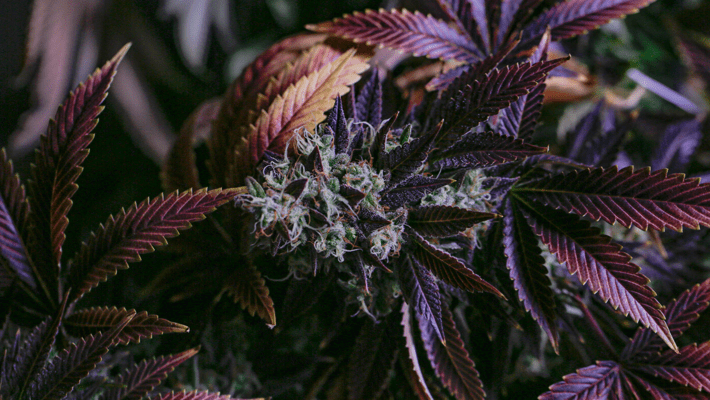
Why Does Weed Have Different Colors?
Published on 5/13/21
People often talk about tasting and eating the rainbow, but do you ever hear about smoking the rainbow, too? Colorful weed is abundant and certain hues are even sought after for certain effects, but many don't know the reason behind these different tones. Your beloved bud can be anywhere on the color wheel, and we're here to tell you how it got there and exactly what it means for your cannabis experience.
Colorful Marijuana Plants
 Unsplash
UnsplashTo begin, as a young marijuana plant, most strains are naturally a green hue, ranging from the lightest, almost neon to deep, forest green colors. As maturity happens, the young plants continue to flower and produce more colors in both the leaves and marijuana bud and occurs in the latter half of the flowering stage.
The Building Blocks of Color
When thinking about cannabis color, anthocyanins, flavonoids and carotenoids are the main types of compounds that produce the pigments found on cannabis. Anthocyanins are a type of flavonoid and are made of about 400 water-soluble pigments that become red, blue or purple depending on the pH. Carotenoids are created by plants, algae and photosynthetic bacteria and give those yellow, red and orange hues. All of these pigments are also found on the likes of fruits and vegetables that give them their colorful variety, however, it has nothing to do with the taste.
How Growing Conditions Can Affect Color
 Unsplash
UnsplashThinking about how marijuana changes colors can directly parallel to the way the leaves change in autumn. Strain depending, of course, colors begin to appear when the temperature is dropped, which is a result of chlorophyll (a green pigment) production slowing down. Once this production slows and eventually comes to a halt, the green disappears, leaving you with some vibrant colors that can shine through.
The acidity and alkalinity of the soil or growing medium are also paramount, as each color will have an ideal pH growing range. For example, acidic conditions tend to bring out a red or pink hue, whereas an alkaline environment will produce yellow forward strains.
Genetics, as always, plays a role in weed colors, as some strains naturally contain higher levels of anthocyanins or other types of pigments than others.
What Does Color Affect When Consuming Cannabis?
Many believe rumors that purple kush is more potent than other colors of bud. Unfortunately, that is a myth, as color doesn't equate to a certain potency level. However, these compounds, such as anthocyanins and carotenoids, do in fact have some potential benefits for humans. These chemicals contain antioxidant, anti-inflammatory and immune-stimulating properties that can aid in cancer and cardiovascular prevention. There is also research to suggest that anthocyanins possibly have an attraction to the receptors in the endocannabinoid system. This would lead to a contribution to the entourage effect, which is when various compounds such as terpenes, come together to create positive outcomes.
A More In-Depth Look at Color
Purple Strains
 Unsplash
UnsplashAs noted earlier, unfortunately, those famous purple weed strains aren't going to be any more potent than strains of a different color. Interestingly enough, purple is one of the most common hues for cannabis, too. To achieve the purple hue, the strain will need to have a large amount of anthocyanin. You can find it producing that hue that in blueberries, eggplants and grapes. Purple strains also thrive in a neutral pH environment, with low temperatures where the chlorophyll breaks down enough for the purple to shine through.
Green Strains
While green marijuana may not be the most fun, it means that there is a happy and healthy plant there, perfect for smooth weed and plenty of kief. The cannabis plant is an annual one. So for most of its life, it is green due to the chlorophyll present. If you see a strain that has retained its green color, that just means that the plant tissue has so much chlorophyll that it will mask the presence of other pigments.
Red Strains
Typically, red weed flowers and leaves are rare. Growers who are after a red marijuana strain can manipulate some variables, through a deprivation of phosphorus and other nutrients, which is vital to plant physiology. This doesn't happen often within marijuana growing, but if it does, often the manipulation results in spotted, stiff leaves rather than a vibrant red stem. If you're lucky enough to find a red strain, it will give you the same psychoactive effects as any other strain.
Orange Strains
 Unsplash
UnsplashThe orange hue is derived from carotenoids, which produce the colors on the likes of carrots, squash, sweet potatoes and pumpkins. Orange and yellow hues will come from high alkaline soil, or high pH, soil. There are over 750 carotenoids known, which are hugely important for eye health and protects against macular degeneration and blue light. Some flavonoids contain these hues that contribute to the marijuana bud color. If a strain is looking slightly yellow, there could also be a nitrogen deficiency present, but it is also very common for varieties of marijuana to contain orange pistils, or hairs, as well.
What color is your favorite strain of weed? Do you notice any specific benefits from the color present? Let us know in the comments below.
